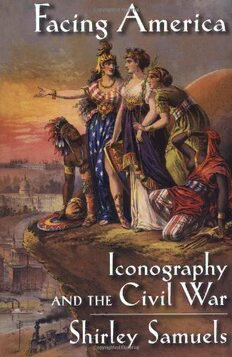Table Of ContentFacing America:
Iconography and the
Civil War
Shirley Samuels
OXFORD UNIVERSITY PRESS
Facing America
This page intentionally left blank
FACING
America
ICONOGRAPHY AND THE CIVIL WAR
Shirley Samuels
1
2004
3
Oxford New York
Auckland Bangkok Buenos Aires Cape Town Chennai
Dar es Salaam Delhi Hong Kong Istanbul Karachi Kolkata
Kuala Lumpur Madrid Melbourne Mexico City Mumbai Nairobi
São Paulo Shanghai Taipei Tokyo Toronto
Copyright © 2004 by Oxford University Press, Inc.
Published by Oxford University Press, Inc.
198 Madison Avenue, New York, New York 10016
www.oup.com
Oxford is a registered trademark of Oxford University Press
All rights reserved. No part of this publication may be reproduced,
stored in a retrieval system, or transmitted, in any form or by any means,
electronic, mechanical, photocopying, recording, or otherwise,
without the prior permission of Oxford University Press.
Library of Congress Cataloging-in-Publication Data
Samuels, Shirley.
Facing America : iconography and the Civil War / Shirley Samuels.
p. cm.
Includes bibliographical references and index.
ISBN 0-19-512897-4
1. United States—History—Civil War, 1861–1865—Influence.
2. United States—History—Civil War, 1861–1865—Pictorial works.
3. Nationalism—United States—History—19th century. 4. Political culture—
United States—History—19th century. 5. Sex role—Political aspects—
United States—History—19th century. 6. Signs and symbols—
Political aspects—United States—History—19th century.
7. Women in art. 8. Women in literature. 9. Masculinity
in art. 10. Masculinity in literature. I. Title.
E468.9 .S25 2003
973.7—dc21 2003006305
1 3 5 7 9 8 6 4 2
Printed in the United States of America
on acid-free paper
For Ruth and John: their love sustains me
This page intentionally left blank
A
CKNOWLEDGMENTS
Over the past few turbulent years, in locations from Santa Cruz to Delaware,
from Wisconsin to Ithaca, from Puerto Vallarta to San Antonio, from Can-
cun to Berlin, I have benefited from the encouragement of many friends and
colleagues. Knowing that these lists are inadequate, I want to thank: Dale
Bauer, Gretchen Bauer, Laura Brown, Martin Brueckner, Annie Burns,
Cynthia Chase, Eric Cheyfitz, Walter Cohen, Ray Craib, Joe Donahue, Lisa
Dundon, Zoe Forrester, Ellen Gainor, Keith George, Susan Gillman, Jackie
Goldsby, Leslie Goldstein, Kirsten Silva Gruesz, Salah Hassan, Gordon Hut-
ner, Virginia Jackson, Anatole Krattiger, Mary Loeffelholz, Michelle Massie,
Harryette Mullen, Jean Pfaelzer, Mary Roldan, Rebecca Schneider, Eric
Sundquist, Candace Waid, Priscilla Wald, and Elizabeth Young. The personal
and political especially joined for me in the many conversations with Mary,
Lisa, Kirsten, Leslie, Laura, and Jackie. My graduate students at Cornell Uni-
versity and the University of Delaware gave these ideas voice and momen-
tum through stimulating exchanges. Late in the project, I had inspiring
conversations with, among others, Alicia Anderson, Hilary Emmett, and
Shirleen Robinson. A particular thanks to Darlene Flint and Heather Gowe
for crisis management in the office.
I also want to thank my extended family again. More and more I am
grateful for their roles in my life: Larry, Nils, Rolf, Lisa, Joel, Maya, Christy,
Ali, Amy, Sarah, Margaret Ann, Marilyn, Larry, Lucia, and my grandmother
Helen.
Very special thanks are offered to those who have helped with my chil-
dren: Alicia Anderson, Mattias Bjork, Kusum Dave, Monica Espinoza,
viii ACKNOWLEDGMENTS
Mohsina Khanam, Ernest Mlynarczyk, Pernilla Svensson, and Ivaylo Tsenov.
Hours in front of the computer were made more precious knowing that my
children were with those who showed them love. Michelle Massie not only
brought my daughter Ruth into the world, she also cooked us all dinner the
next evening.
Portions of this book were delivered as lectures in the following locations:
the University of California at Santa Barbara, the University of California at
Santa Cruz, the University of Wisconsin at Madison, the University of
Delaware, Johns Hopkins University, Rutgers University, the University
of Washington at Seattle, the Free University of Berlin, and at conferences
in Munich, Potsdam, Cancun, Puerto Vallarta, and the Ukraine. I am
very grateful to those audiences for their feedback. Research for the book
was aided by generous librarians at the American Antiquarian Society, the
Library of Congress, the Library Company of Philadelphia, the Huntington
Library, and Kroch Library at Cornell University. Permission has been
received from American Literary History and Cambridge University Press for
reprinting sections of chapters 2 and 4 that appeared in their pages.
C
ONTENTS
LIST OF ILLUSTRATIONS xi
INTRODUCTION 3
The Four Continents 3
Looking into the Archive 6
My Grandmother’s Hand 9
The Currency of America 11
1. FACING WEST 16
Land Claims 16
The Muse of History 19
Men on the Run 24
Women Who Fight 30
Haunted Houses 35
2. MISCEGENATED AMERICA 41
Monstrous Birth 41
The President’s Dream 46
Buying Philadelphia 50
Twins 54
3. THE FACE OF THE NATION 58
“The Youngster’s Face” 59
The Surgeon’s Eye 62
“Weird Copies of Carnage” 70
Repetition 76
Body Poses 79

